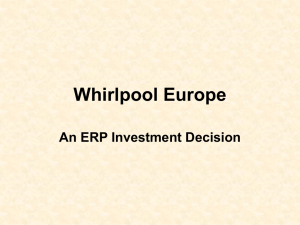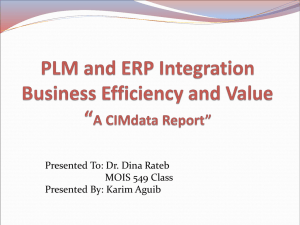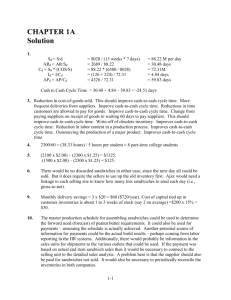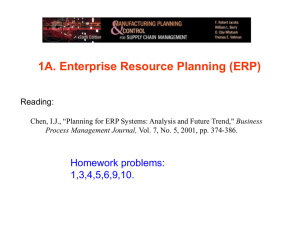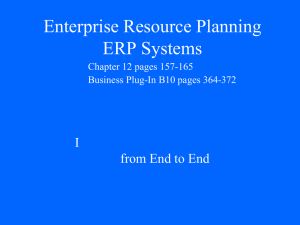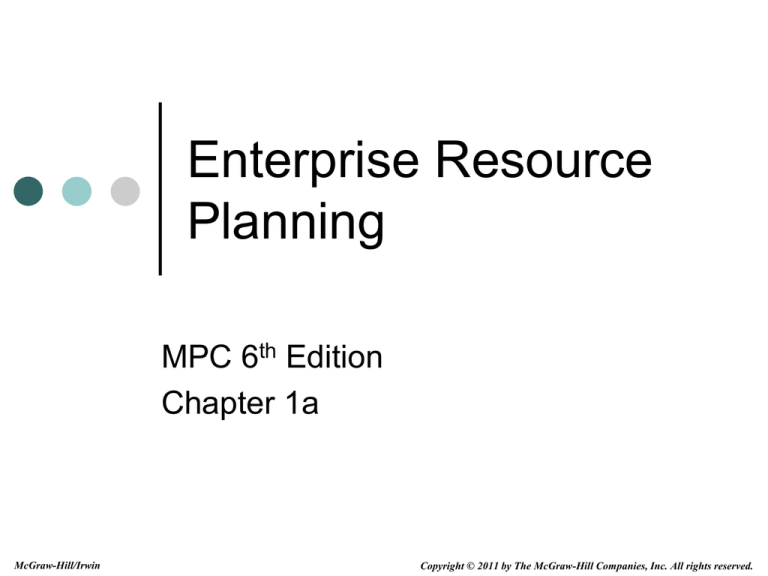
Enterprise Resource
Planning
MPC 6th Edition
Chapter 1a
McGraw-Hill/Irwin
Copyright © 2011 by The McGraw-Hill Companies, Inc. All rights reserved.
Enterprise Resource Planning
A comprehensive software approach to
support decisions concurrent with
planning and controlling the business.
ERP systems are, first and foremost,
integrated.
1a-2
Agenda
What is ERP?
Connecting functional units with ERP
The need for standardization
Support of MPC decisions
Transaction processing
Performance metrics
The ERP experience
1a-3
What is ERP?
ERP software is
Multifunctional
Integrated
Modular
Able to facilitate MPC activities
1a-4
Multifunctional
The ability to track financial
performance in monetary terms ($, €)
Can track purchasing activity in
material units (pounds, kilos, tons)
Follows sales in terms of products or
services
Reports manufacturing activity in
terms of products, resources, or
people
1a-5
ERP Scope
Enterprise resource
planning
Manufacturing
and logistics
Enterprise planning models
Manufacturing
planning and
control
Enterprise performance
measures
Sales and operations
planning (front end)
Data warehousing
Material and capacity
planning (engine)
Report generation
Material and vendor
management
(back end)
Human resource
management
Finance
Sales and
marketing
Transaction processing
1a-6
Integrated
Data entered by one functional area
updates all other functional areas
Eliminates
reposting of
data
(errors)
Ensures a
common
vision
1a-7
Modular
Functional units (finance, sales,
manufacturing, etc.) are narrowly
focused
Functional units can be combined to
create a single system
Software from other sources can be
connected as well
1a-8
Forecasting
Production planning
MPC
Activity
Support
Material planning
Inventory
management
1a-9
Process Standardization
Without standard terminology,
integration is impossible
What is demand?
What is inventory?
How are exchange rates determined?
What transfer costs apply (for internal
transactions)?
What labor rates are applied?
1a-10
Decision Support
Helping users make decisions about
running the business
People make the decisions, software
provides them with better tools and
information
1a-11
Transaction Processing
An ERP system is designed to
process business transactions in real
time, working from a single database
Data warehouse software may be
added to facilitate queries not built
into the ERP system
1a-12
Performance Metrics
Functional Silos – Each area is responsible for
optimizing its own operation, with no
consideration for how the overall firm is affected
Purchasing
pursues cost
rather than
quality
Manufacturing
Distribution
builds long
focuses on
runs rather
cost of delivery
than
stages instead
responding to of total system
customers
costs
1a-13
Integrated Supply Chain
Metrics
Developed by the Supply Chain
Council
Designed to measure the impact of
decisions on the entire supply chain
Avoids development of functional silos
by developing metrics that reflect the
entire supply chain
1a-14
Source: Supply Chain Council
Supply Chain Metrics
Measure
Description
Best-inClass
Average
Delivery
performance
Percentage of orders shipped according to
schedule
93%
69%
Fill rate by line
item
Percentage of actual line items filled
97%
88%
Perfect order
fulfillment
Complete orders shipped on time
92.4%
65.7%
Order fulfillment
lead time
Time from when an order is placed until it is
received by the customer
135 days
225 days
Warranty cost
Warranty expenses as a % of revenue
1.2%
2.4%
Inventory
Days of supply held in inventory
55 days
84 days
Cash-to-cash
cycle time
Time required to turn cash used to purchase
raw materials into cash received from
customers
35.6 days
99.4 days
Asset turns
Measure of how many times per year assets
are used to generate revenue
4.7 turns
1.7 turns
1a-15
Cash-to-Cash Cycle Time
Integrates the finance function with
purchasing, manufacturing, and
sales/distribution
Cash-to-cash cycle time = Inventory days of supply + Days of sales outstanding
– Average payment period for material
Procurement
cycle
Manufacturing
cycle
•Purchase cost of material
•Accounts payable
•Raw materials inventory
•Work-in-process
•Finished goods inventory
Sales and
distribution cycle
•Distribution inventory
•Accounts receivable
1a-16
ERP View of Cash-to-Cash
Time
ERP database
Purchasing
Accounts payable
Inventory
Manufacturing
Sales and
distribution
Cost of sales
Cash-to-cash
cycle time
Sales
Accounts receivable
1a-17
Calculating Cash-to-Cash Time
Sd
Average daily sales (Sd)
S
d
AR
d
Accounts receivable days (ARd)
ARd
Average daily cost of sales (Cd)
Cd Sd CS
I
Cd
Average days of inventory (Id)
Id
Accounts payable cycle time (APd)
APd
Cash-to-cash cycle time
AP
Cd
Cash to cash cycle time ARd I d APd
1a-18
Cash-to-Cash Example
Sales over last 30 days = $1,020,000
Accounts receivable = $200,000
Sd
ARd
S 1,020 ,000
34,000
d
30
AR 200 ,000
5.88 days
d
34000
Inventory value = $400,000
Cd Sd CS 34,000(0.6) 20,400
Cost of sales = 60% of total sales
Accounts payable = $160,000
Id
I
400,000
19.6 days
Cd
20,400
APd
AP 160,000
7.84 days
Cd
20,400
Cash to cash cycle time ARd I d APd 5.88 19.6 7.84 17.64 days
1a-19
The ERP Experience
Eli Lilly and Company
Integration of a global company
Process improvement
Simplified training
Strategic direction
Organizational flexibility
Set of global policies
1a-20
Concluding Principles
Redundant transactions must be
reduced or eliminated.
To maintain data accuracy and realize
efficiencies, information must be
captured at the initial entry, using
documented processes.
Processes need to be changed to
support the data needs of the ERP
system–hardware and software alone
isn’t sufficient.
1a-21
Concluding Principles
The company must define a
comprehensive set of performance
measures, with policies and goals that
correspond to these measures.
IT economies of scale can be
obtained from supporting fewer
hardware and software platforms.
1a-22
Quiz – Chapter 1a
To free the ERP system for basic applications, a _______
_______ is often used to capture, manage, and analyze
data.
For a firm with average daily sales (Sd) of $200,000, current
inventory (I) of $1,000,000, and cost of sales (CS) of 50%,
what is the average days of inventory (Id)?
Which of the following actions would be likely to increase
the cash-to-cycle time for a firm?
• Increasing the cost, but not the price, of the product
• Taking advantage of “early pay” discounts with suppliers
• Revaluing inventory to reflect reductions in purchasing prices
1a-23

